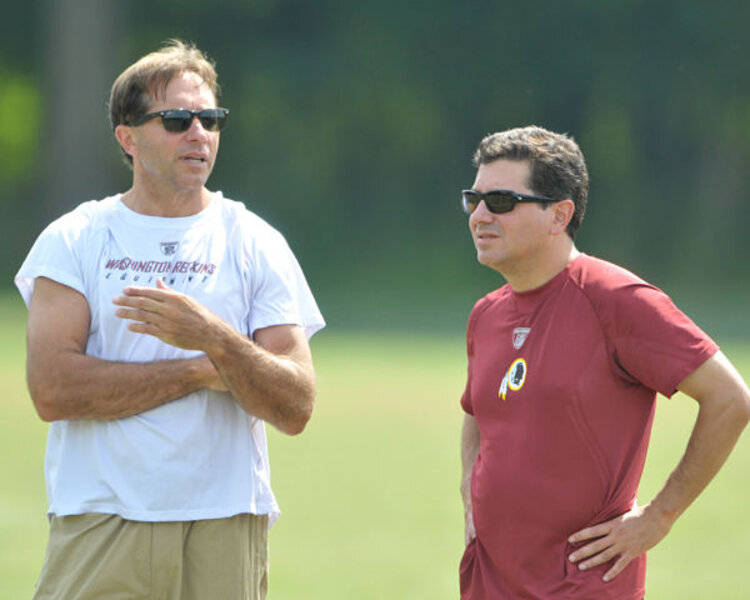Vinny Cerrato out, Bruce Allen in. What financial havoc did Cerrato wreck?
Loading...
Vinny Cerrato's resignation as executive vice president of football operations for the Washington Redskins elicited an overwhelming schadenfreude from the battered fans of one of the NFL's flagship franchises.
"If only there was a statue of Cerrato we could yank down," tweeted Maryland-based writer Mark Newgent.
Cerrato's tenure with the Redskins saw quite a few successes. He drafted the late great safety Sean Taylor and pulled All-Pro tight end Chris Cooley from the 3rd round rough in the 2004 NFL Draft. He traded for stalwart wideout Santana Moss in 2005 and signed middle linebacker London Fletcher in 2007.
And it's not hard to imagine that some of the angst directed at Cerrato was a general ill will toward Redskins management, which has much to do with the owner, Daniel Snyder,
But professional football is a business, in the end, in which managers must attract the best talent at the cheapest cost. In that light, Cerrato's tenure will be remembered by a string of high-profile busts and vapid drafting strategy that ended with overpayed and underperforming duds. Here are the three ways that Cerrato not only made the Redskins a poor on-the-field product but expensive as well:
1. Swapping draft picks for established players.
The NFL draft is a way for teams to retool with cheap talent. Throughout Cerrato's tenure, the Redskins have generally treated the draft like a rough neighborhood, passing through it only when necessary, and then trading the draft picks away. That can be a viable strategy, unless you overpay.
For example: When Cerrato exchanged a first-round draft pick for Jets wideout Laveranues Coles in 2003, the Redskins got a player who had been making less than $400,000. But the Redskins signed him to a contract with a $13 million signing bonus and a base salary of over $2 million. After two less-than-stellar seasons in Washington, Coles was traded back to the Jets (for wide receiver Santana Moss) with a signing bonus that was $8 million less than what he had received from the Redskins.
That same year, the Redskins made only three picks in the roughly 250 selection draft. In a league where homegrown talent like Steelers safety Troy Polamalu (a first-round choice in 2003) and Patriots quarterback Tom Brady (a sixth-round pick in 2000) are keys to long-term success, the Redskins consistently moved out of the draft in favor of expensive veterans.
2. Taking on players past their prime
Cerrato worked in the Redskins front office between 1999 and 2001 before returning to the Redskins in 2002. Since 2002, Cerrato took out fliers on aging players like Adam Archuleta ($5.5 million in 2006), Jessie Armstead ($2 million in 2002 and 2003), and Jason Taylor ($8 million in 2008), who cashed their checks but just didn't check out on the gridiron.
During his first tenure with the Redskins, he helped assemble one of the most absurd collections of past-their-prime future Hall of Famers and other assorted graybeards on one roster in NFL history.
The 2000 Washington Redskins featured future NFL sack leader Bruce Smith at defensive end (roughly $13 million over his four years in Washington), once-flashy cornerback Deion Sanders ($1.5 million in 2000), hardy free safety Mark Carrier ($1 million in 2000), and tempestuous quarterback Jeff George ($1 million in 2000) in what was then the most highly paid NFL roster of all time. The return on all those greenbacks? An 8-8 record, no trip to the playoffs, and the firing of head coach Norv Turner. Which brings us to..
3. Running the coaching carousel
Here is where Cerrato's performance admittedly is hardest to separate from Snyder's, an owner whose most enduring bond with head coaches not named Joe Gibbs has been a lack of patience.
But the economic consequences are staggering. Beginning in 2000, Marty Schottenheimer inked a four year, $10 million deal. He lasted one season before being replaced by Florida head coach Steve Spurrier, who signed a five-year, $25 million deal that was the richest in the NFL at the time.
By comparison, in 2009 Spurrier's contract would have put him in the top 10 paid coaches in the NFL, on par with three-time Super Bowl winner Bill Belichick.
Spurrier lasted two painful seasons before being replaced by legendary Redskins coach Gibbs in an identical deal. Gibbs resigned before the 2008 season to be replaced by Jim Zorn, whose deal spans five years and $15 million. The Redskins 5-9 performance iso far n 2009 has led many to speculate that his second season in Washington will probably be Zorn's last.
But it will definitely be Cerrato's last. And perhaps the end is fitting for a man Redskin loyalists love to hate: There's no statue to topple because Cerrato's legacy includes few, if any, lasting accomplishments.





